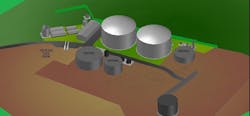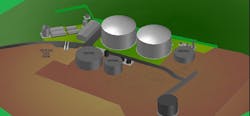Waste cheese turned to biogas in UK anaerobic digestion project
Anaerobic Digestion(AD)company Clearfleau has finished the first stage in a major project for First Milk, at one of the UK's largest cheese creameries.
Once operational, the plant will feed bio-methane into the gas grid - the first dairy processing site in Europe to do so.
Lake District Biogas (LDB), a company set up to manage the project for First Milk, has commissioned Clearfleau to design, build and operate the bio-energy plant at the cheese creamery in Aspatria, rural Cumbria.
Revenue benefits will include 20-year index-linked, government-backed incentive (FiT and RHI) payments.
When commissioned, the digesters will generate 1000 m3/ day of biogas, much of which will be upgraded for injection into the national grid.
Some bio-methane will be used in the creamery for steam generation while the rest of the gas will be consumed by local users.
The feedstock from the Aspatria creamery site comprises low-strength wash waters such as process rinses, supplemented by whey permeate (cheese production residue after protein extraction for use in energy supplements). This will be pumped to the AD plant from the creamery.
As an initial step, Clearfleau refurbished the existing aerobic plant to help significantly reduce levels of phosphate in its effluent, which is discharged to the River Ellen. This will ensure an early delivery of new tighter discharge standards, which are required by the Water Framework Directive.
Stewart Mounsey, environment manager at the Environment Agency, said: “This will make a significant contribution towards the reduction in phosphate levels in the river. It’s important for the health of our rivers and streams that businesses do their bit to help reduce pollution and improve water quality.”
The integrated on-site AD plant will take over from the existing aerobic plant in early 2016 and will treat the creamery’s wastewater output as well as its whey permeate.
Clearfleau said its on-site AD technology can reduce the chemical oxygen demand (COD) of the production residues by 95%. Aerobic polishing will then remove residual COD and nutrients (nitrates and phosphates) to allow safe river discharge.
Craig Chapman, CEO of Clearfleau, said: “Use of aerobic treatment for dairy processing residues is outdated. The revenue and energy contribution from AD offers a much better return than a new aerobic plant. Moreover most AD systems are not suited to dairy feedstock or treating feedstock containing fatty residues.
“The project will generate biogas solely from cheese production residues, using advanced British technology. It is a very positive move by First Milk to future proof their leading creamery operation by generating a significant proportion of their site’s future energy needs.”
###
Read more

